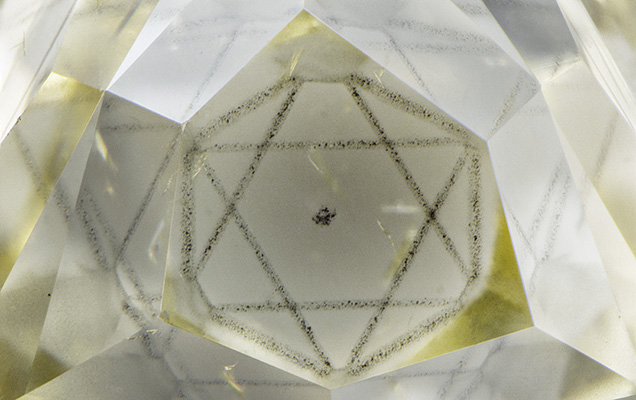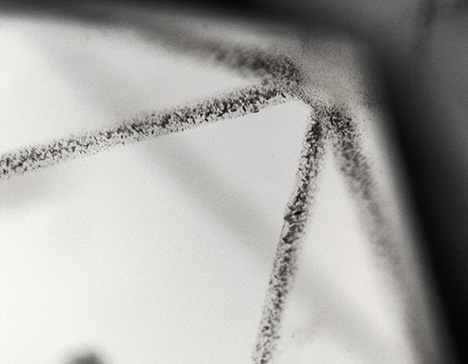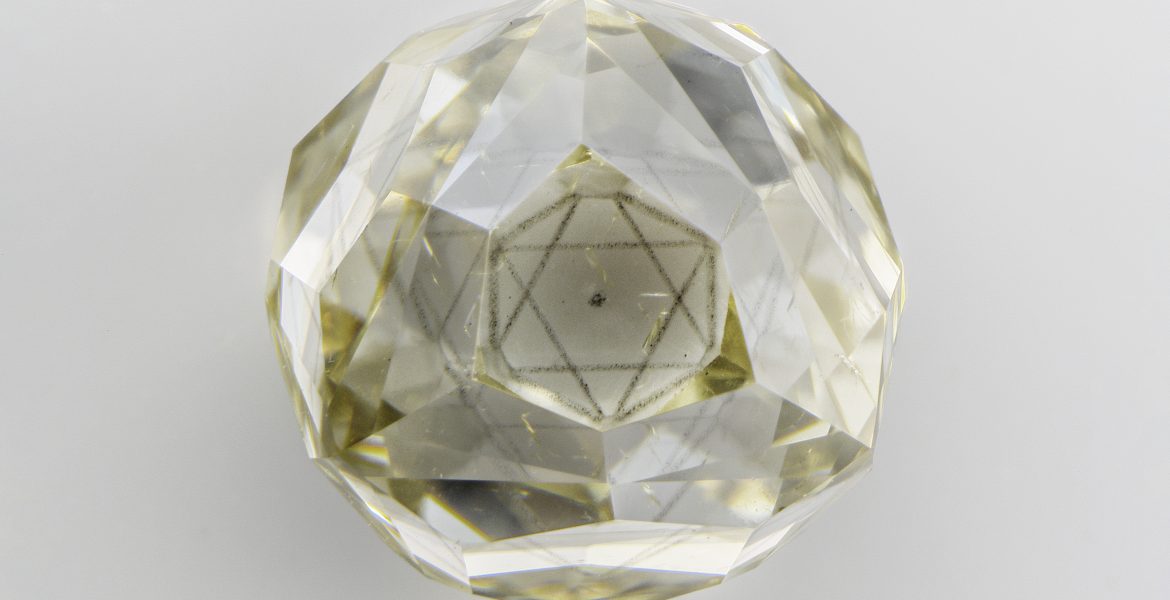Recently, the authors examined a 2.01 ct faceted diamond octahedron (6.28 × 5.98 × 7.14 mm) with a Fancy Light brownish greenish yellow color grade that showed a distinctive internal appearance (figure 1). Microscopic examination revealed an octahedral-shaped inclusion scene composed of minute inclusions and clouds. The faceting arrangement of the diamond was likely meant to highlight the octahedron.

Viewed from one perspective, the hexagonal facet shows the internal octahedron in such a way that the inclusion scene resembles a six-pointed star (e.g., figure 2; see the video). Similar octahedral-shaped inclusions have been encountered before in natural diamonds (Winter 2015 Lab Notes, pp. 428–429; Spring 2011 Lab Notes, pp. 50–52).

Oftentimes, such symmetrical clouds are dark-colored or gray (W. Wang and W. Mayerson, “Symmetrical clouds in diamond—The hydrogen connection,” Journal of Gemmology, Vol. 28, No. 3, 2002, pp. 143–152). These can also contain evidence of hydrogen, nickel-related defects, or graphite (S. Eaton-Magaña et al., “Inclusion and point defect characteristics of Marange,” Diamond and Related Materials, Vol. 71, 2016, pp. 20–29). At higher magnification, the individual inclusions that combine to create the cloud can be seen (figure 3).
The cloud inclusion resulted in an SI1 clarity grade. The diamond exhibited no fluorescence to long-wave UV and blue N3-related fluorescence within the diamond when exposed to the deep UV within the DiamondView. The cloud inclusion itself showed no distinctive fluorescence compared to the rest of the diamond. The IR absorption spectrum indicated the presence of strong nitrogen aggregates and a strong hydrogen peak at 3107 cm–1 associated with the N3VH defect. The visible/near-infrared absorption spectrum contained typical cape features and a hydrogen-related band at 835 nm. The hydrogen features detected in the IR and Vis-NIR absorption spectra correspond with the presence of the octahedral cloud inclusion.

Spectroscopically, the most interesting results came from photoluminescence (PL) mapping of the octahedral-shaped cloud inclusion. This was performed at liquid nitrogen temperature using 532 and 455 nm excitations. Using 532 nm excitation, we saw elevated concentrations of peaks at 694 and 700.5 nm within the cloud inclusion (figure 4). The elevated concentrations of these peaks are consistent with previously characterized hydrogen clouds (e.g., Fall 2020 Lab Notes, pp. 416–419). The 694 and 700.5 nm peaks are ascribed to nickel and are often seen in hydrogen-rich diamonds (K. Iakoubovskii and G.J. Adriaenssens, “Optical characterization of natural Argyle diamonds,” Diamond and Related Materials, Vol. 11, No. 1, 2002, pp. 125–131). In the 455 nm PL mapping, a nickel-nitrogen-related defect at 496.7 nm called the S3 center (T. Hainschwang et al., “The Rhodesian Star: An exceptional asteriated diamond,” Journal of Gemmology, Vol. 34, No. 4, 2014, pp. 306–315) was also detected within the cloud. Outside of the inclusion, we detected higher concentrations of the NV– defect (principal emission at 637 nm).
While the faceting pattern dramatically highlights the octahedral-shaped inclusion to resemble a six-pointed star, the cloud is not confined to a narrow focal plane as it might appear in figures 1 and 2. Instead, the cloud spans throughout much of the volume of the faceted stone. Creative faceting by the polisher provides a unique perspective on the cloud inclusion that makes this unusual diamond even more memorable.
This article is republished with permission from the GIA.
https://www.gia.edu/gems-gemology/fall-2021-microworld-diamond-octahedral-inclusion

